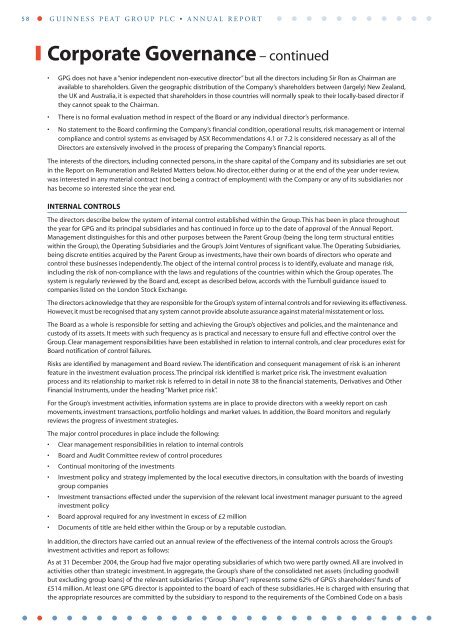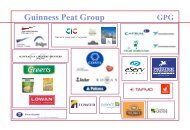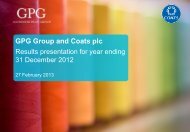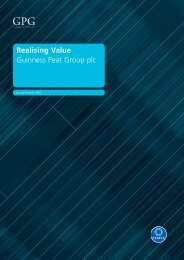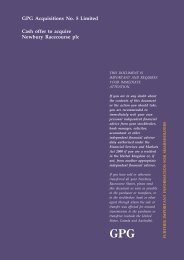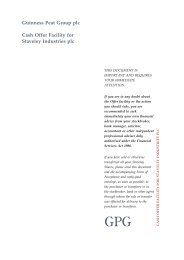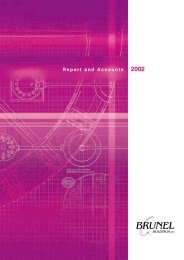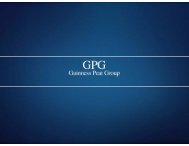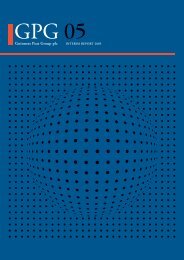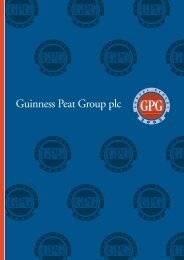Guinness Peat Group plc
Notes to Financial Statements - Guinness Peat Group plc
Notes to Financial Statements - Guinness Peat Group plc
Create successful ePaper yourself
Turn your PDF publications into a flip-book with our unique Google optimized e-Paper software.
58 GUINNESS PEAT GROUP PLC • ANNUAL REPORTCorporate Governance – continued• GPG does not have a “senior independent non-executive director” but all the directors including Sir Ron as Chairman areavailable to shareholders. Given the geographic distribution of the Company’s shareholders between (largely) New Zealand,the UK and Australia, it is expected that shareholders in those countries will normally speak to their locally-based director ifthey cannot speak to the Chairman.• There is no formal evaluation method in respect of the Board or any individual director’s performance.• No statement to the Board confirming the Company’s financial condition, operational results, risk management or internalcompliance and control systems as envisaged by ASX Recommendations 4.1 or 7.2 is considered necessary as all of theDirectors are extensively involved in the process of preparing the Company’s financial reports.The interests of the directors, including connected persons, in the share capital of the Company and its subsidiaries are set outin the Report on Remuneration and Related Matters below. No director, either during or at the end of the year under review,was interested in any material contract (not being a contract of employment) with the Company or any of its subsidiaries norhas become so interested since the year end.INTERNAL CONTROLSThe directors describe below the system of internal control established within the <strong>Group</strong>. This has been in place throughoutthe year for GPG and its principal subsidiaries and has continued in force up to the date of approval of the Annual Report.Management distinguishes for this and other purposes between the Parent <strong>Group</strong> (being the long term structural entitieswithin the <strong>Group</strong>), the Operating Subsidiaries and the <strong>Group</strong>’s Joint Ventures of significant value. The Operating Subsidiaries,being discrete entities acquired by the Parent <strong>Group</strong> as investments, have their own boards of directors who operate andcontrol these businesses independently. The object of the internal control process is to identify, evaluate and manage risk,including the risk of non-compliance with the laws and regulations of the countries within which the <strong>Group</strong> operates. Thesystem is regularly reviewed by the Board and, except as described below, accords with the Turnbull guidance issued tocompanies listed on the London Stock Exchange.The directors acknowledge that they are responsible for the <strong>Group</strong>’s system of internal controls and for reviewing its effectiveness.However,it must be recognised that any system cannot provide absolute assurance against material misstatement or loss.The Board as a whole is responsible for setting and achieving the <strong>Group</strong>’s objectives and policies, and the maintenance andcustody of its assets. It meets with such frequency as is practical and necessary to ensure full and effective control over the<strong>Group</strong>. Clear management responsibilities have been established in relation to internal controls, and clear procedures exist forBoard notification of control failures.Risks are identified by management and Board review. The identification and consequent management of risk is an inherentfeature in the investment evaluation process. The principal risk identified is market price risk. The investment evaluationprocess and its relationship to market risk is referred to in detail in note 38 to the financial statements, Derivatives and OtherFinancial Instruments, under the heading “Market price risk”.For the <strong>Group</strong>’s investment activities, information systems are in place to provide directors with a weekly report on cashmovements, investment transactions, portfolio holdings and market values. In addition, the Board monitors and regularlyreviews the progress of investment strategies.The major control procedures in place include the following:• Clear management responsibilities in relation to internal controls• Board and Audit Committee review of control procedures• Continual monitoring of the investments• Investment policy and strategy implemented by the local executive directors, in consultation with the boards of investinggroup companies• Investment transactions effected under the supervision of the relevant local investment manager pursuant to the agreedinvestment policy• Board approval required for any investment in excess of £2 million• Documents of title are held either within the <strong>Group</strong> or by a reputable custodian.In addition, the directors have carried out an annual review of the effectiveness of the internal controls across the <strong>Group</strong>’sinvestment activities and report as follows:As at 31 December 2004, the <strong>Group</strong> had five major operating subsidiaries of which two were partly owned. All are involved inactivities other than strategic investment. In aggregate, the <strong>Group</strong>’s share of the consolidated net assets (including goodwillbut excluding group loans) of the relevant subsidiaries (“<strong>Group</strong> Share”) represents some 62% of GPG’s shareholders’ funds of£514 million. At least one GPG director is appointed to the board of each of these subsidiaries. He is charged with ensuring thatthe appropriate resources are committed by the subsidiary to respond to the requirements of the Combined Code on a basis


